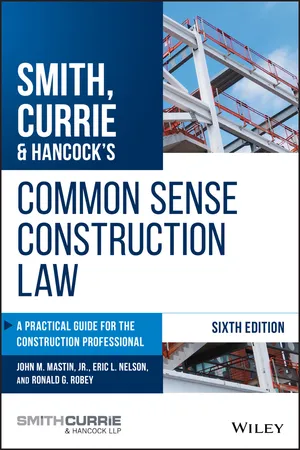
Smith, Currie & Hancock's Common Sense Construction Law
A Practical Guide for the Construction Professional
- English
- ePUB (mobile friendly)
- Available on iOS & Android
Smith, Currie & Hancock's Common Sense Construction Law
A Practical Guide for the Construction Professional
About this book
The #1 construction law guide for construction professionals
Updated and expanded to reflect the most recent changes in construction law, this practical guide teaches readersthe difficult theories, principles, and established rules that regulate the construction business. It addresses the practical steps required to avoid and mitigate risks—whether the project is performed domestically or internationally, or whether it uses a traditional design-bid-build delivery system or one of the many alternative project delivery systems.
Smith, Currie & Hancock's Common Sense Construction Law: A Practical Guide for the Construction Professional provides a comprehensive introduction to the important legal topics and questions affecting the construction industry today. This latest edition features: all-new coverage of Electronically Stored Information (ESI) and Integrated Project Delivery (IPD); extended information on the civil False Claims Act; and fully updated references to current AIA, ConsensusDocs, DBIA, and EJDC contract documents. Chapters coverthe legal context of construction; interpreting a contract; public-private partnerships (P3); design-build and EPC; and international construction contracts. Other topics include: management techniques to limit risks and avoid disputes; proving costs and damages, including for changes and claims for delay and disruption; construction insurance, including general liability, builders risk, professional liability, OCIP, CCIP, and OPPI; bankruptcy; federal government construction contracting; and more.
- Fully updated with comprehensive coverage of the significant legal topics and questions that affect the construction industry
- Discusses new project delivery methods including Public-Private Partnerships (P3) and Integrated Project Delivery (IPD)
- Presents new coverage of digital tools and processes including Electronically Stored Information (ESI)
- Provides extended and updated coverage of the civil False Claims Act as it relates to government construction contracting
Filled with checklists, sample forms, and summary "Points to Remember" for each chapter, Smith, Currie & Hancock's Common Sense Construction Law: A Practical Guide for the Construction Professional, Sixth Edition is the perfect resource for construction firm managers, contractors, subcontractors, architects and engineers. It will also greatly benefit students in construction management, civil engineering, and architecture.
Frequently asked questions
- Essential is ideal for learners and professionals who enjoy exploring a wide range of subjects. Access the Essential Library with 800,000+ trusted titles and best-sellers across business, personal growth, and the humanities. Includes unlimited reading time and Standard Read Aloud voice.
- Complete: Perfect for advanced learners and researchers needing full, unrestricted access. Unlock 1.4M+ books across hundreds of subjects, including academic and specialized titles. The Complete Plan also includes advanced features like Premium Read Aloud and Research Assistant.
Please note we cannot support devices running on iOS 13 and Android 7 or earlier. Learn more about using the app.
Information
1
THE LEGAL CONTEXT OF CONSTRUCTION
I. INTRODUCTION
II. CONTRACT LAW
A. What Is a Contract?
B. Breach of Contract
C. Implied Contract Obligations
Table of contents
- COVER
- TABLE OF CONTENTS
- PREFACE
- 1 THE LEGAL CONTEXT OF CONSTRUCTION
- 2 INTERPRETING THE CONTRACT
- 3 ALTERNATIVE CONTRACTING METHODS
- 4 PUBLIC-PRIVATE PARTNERSHIPS
- 5 INTERNATIONAL CONSTRUCTION CONTRACTS
- 6 WORKING IN A DIFFERENT STATE
- 7 COMPETING FOR THE CONTRACT
- 8 THE UNIFORM COMMERCIAL CODE AND THE CONSTRUCTION INDUSTRY
- 9 THE DESIGN PROFESSIONAL'S AUTHORITY AND RESPONSIBILITY
- 10 SUBCONTRACT ADMINISTRATION AND DISPUTE AVOIDANCE
- 11 CONTRACT CHANGES
- 12 DIFFERING SITE CONDITIONS
- 13 SCHEDULES, DELAYS, AND ACCELERATION
- 14 INSPECTION, ACCEPTANCE, WARRANTIES, AND COMMISSIONING
- 15 MANAGEMENT TECHNIQUES TO LIMIT RISKS AND AVOID DISPUTES
- 16 PAYMENT BONDS
- 17 PERFORMANCE BONDS AND TERMINATIONS
- 18 PROVING COSTS AND DAMAGES
- 19 AN OVERVIEW OF ENVIRONMENTAL AND SAFETY CONCERNS ON THE CONSTRUCTION SITE
- 20 CONSTRUCTION INSURANCE
- 21 LABOR AND EMPLOYMENT ISSUES AFFECTING THE CONSTRUCTION INDUSTRY
- 22 BANKRUPTCY IN THE CONSTRUCTION SETTING
- 23 RESOLVING CONSTRUCTION DISPUTES
- 24 FEDERAL GOVERNMENT CONSTRUCTION CONTRACTING—AN OVERVIEW
- INDEX
- END USER LICENSE AGREEMENT